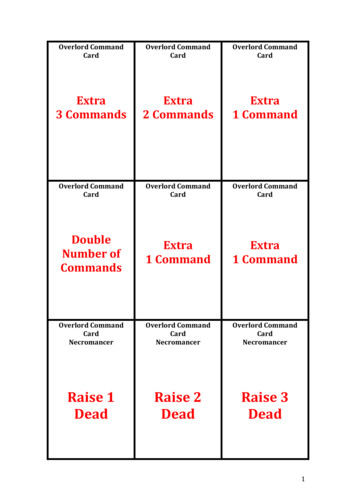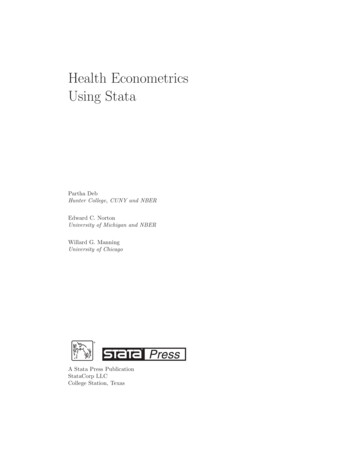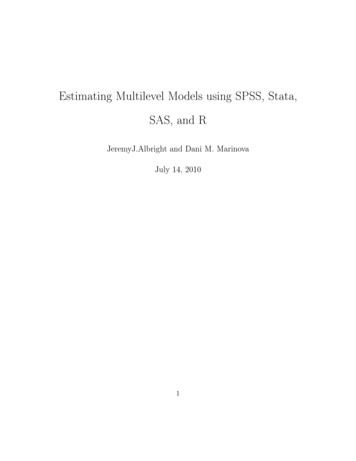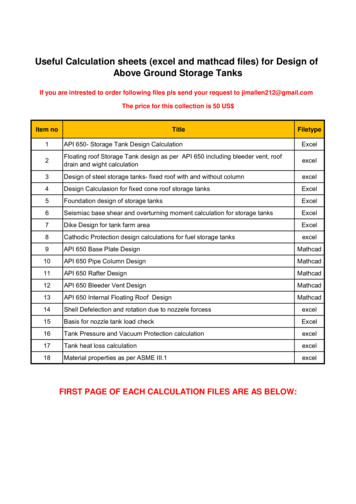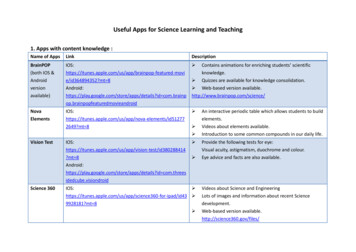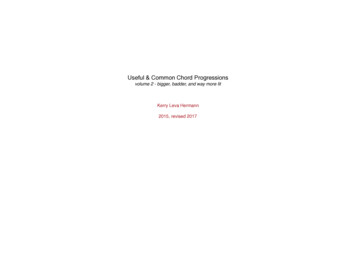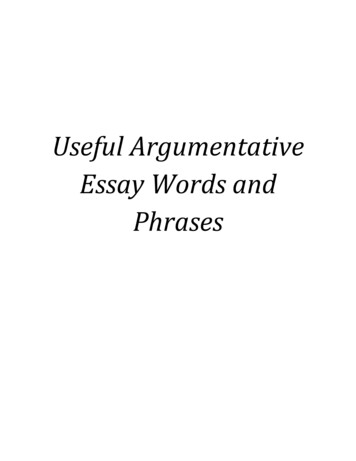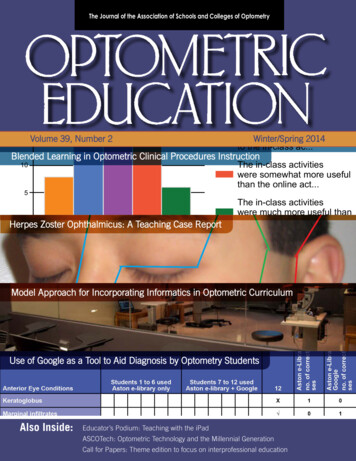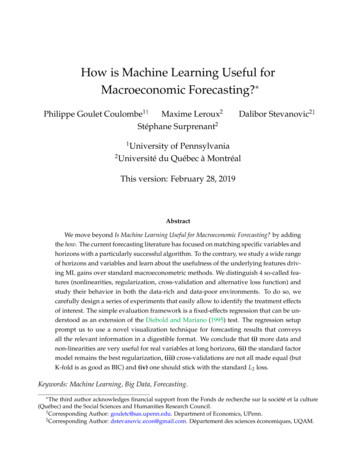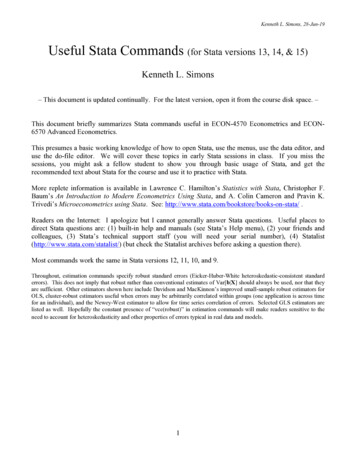
Transcription
Kenneth L. Simons, 28-Jun-19Useful Stata Commands (for Stata versions 13, 14, & 15)Kenneth L. Simons– This document is updated continually. For the latest version, open it from the course disk space. –This document briefly summarizes Stata commands useful in ECON-4570 Econometrics and ECON6570 Advanced Econometrics.This presumes a basic working knowledge of how to open Stata, use the menus, use the data editor, anduse the do-file editor. We will cover these topics in early Stata sessions in class. If you miss thesessions, you might ask a fellow student to show you through basic usage of Stata, and get therecommended text about Stata for the course and use it to practice with Stata.More replete information is available in Lawrence C. Hamilton’s Statistics with Stata, Christopher F.Baum’s An Introduction to Modern Econometrics Using Stata, and A. Colin Cameron and Pravin K.Trivedi’s Microeconometrics using Stata. See: http://www.stata.com/bookstore/books-on-stata/ .Readers on the Internet: I apologize but I cannot generally answer Stata questions. Useful places todirect Stata questions are: (1) built-in help and manuals (see Stata’s Help menu), (2) your friends andcolleagues, (3) Stata’s technical support staff (you will need your serial number), (4) Statalist(http://www.stata.com/statalist/) (but check the Statalist archives before asking a question there).Most commands work the same in Stata versions 12, 11, 10, and 9.Throughout, estimation commands specify robust standard errors (Eicker-Huber-White heteroskedastic-consistent standarderrors). This does not imply that robust rather than conventional estimates of Var[b X] should always be used, nor that theyare sufficient. Other estimators shown here include Davidson and MacKinnon’s improved small-sample robust estimators forOLS, cluster-robust estimators useful when errors may be arbitrarily correlated within groups (one application is across timefor an individual), and the Newey-West estimator to allow for time series correlation of errors. Selected GLS estimators arelisted as well. Hopefully the constant presence of “vce(robust)” in estimation commands will make readers sensitive to theneed to account for heteroskedasticity and other properties of errors typical in real data and models.1
Kenneth L. Simons, 28-Jun-19ContentsPreliminaries: RPI Dot.CIO Labs and Course Disk Space . 5A. Loading Data . 5A1. Memory in Stata Version 11 or Earlier . 5B. Variable Lists, If-Statements, and Options. 6C. Lowercase and Uppercase Letters . 6D. Review Window, and Abbreviating Command Names . 6E. Viewing and Summarizing Data . 6E1. Just Looking . 6E2. Mean, Variance, Number of Non-missing Observations, Minimum, Maximum, Etc. . 7E3. Tabulations, Histograms, Density Function Estimates . 7E4. Scatter Plots and Other Plots . 7E5. Correlations and Covariances. 8F. Generating and Changing Variables . 8F1. Generating Variables . 8F2. Missing Data. 8F3. True-False Variables . 9F4. Random Numbers .10F5. Replacing Values of Variables .10F6. Getting Rid of Variables .10F7. If-then-else Formulas .11F8. Quick Calculations .11F9. More .11G. Means: Hypothesis Tests and Confidence Intervals .11G1. Confidence Intervals .11G2. Hypothesis Tests .12H. OLS Regression (and WLS and GLS) .12H1. Variable Lists with Automated Category Dummies and Interactions .12H2. Improved Robust Standard Errors in Finite Samples .13H3. Weighted Least Squares .13H4. Feasible Generalized Least Squares .14I. Post-Estimation Commands .14I1. Fitted Values, Residuals, and Related Plots .14I2. Confidence Intervals and Hypothesis Tests .14I3. Nonlinear Hypothesis Tests .15I4. Computing Estimated Expected Values for the Dependent Variable.15I5. Displaying Adjusted R2 and Other Estimation Results .16I6. Plotting Any Mathematical Function.16I7. Influence Statistics .17I8. Functional Form Test .17I9. Heteroskedasticity Tests .17I10. Serial Correlation Tests .18I11. Variance Inflation Factors .18I12. Marginal Effects .18J. Tables of Regression Results .192
Kenneth L. Simons, 28-Jun-19J0. Copying and Pasting from Stata to a Word Processor or Spreadsheet Program.19J1. Tables of Regression Results Using Stata’s Built-In Commands .19J2. Tables of Regression Results Using Add-On Commands .20J2a. Installing or Accessing the Add-On Commands .20J2b. Storing Results and Making Tables .21J2c. Near-Publication-Quality Tables .21J2d. Understanding the Table Command’s Options .22J2e. Saving Tables as Files .22J2f. Wide Tables .23J2g. Storing Additional Results .23J2h. Clearing Stored Results.23J2i. More Options and Related Commands .23J3. Tables of Summary Statistics and Tabulations .23K. Data Types, When 3.3 ¹ 3.3, and Missing Values.24L. Results Returned after Commands .25M. Do-Files and Programs .25N. Monte-Carlo Simulations .26O. Doing Things Once for Each Group .27P. Generating Variables for Time-Series and Panel Data .28P1. Creating a Time Variable .28P1a. Time Variable that Starts from a First Time and Increases by 1 at Each Observation .28P1b. Time Variable from a Date String .28P1c. Time Variable from Multiple (e.g., Year and Month) Variables .29P1d. Time Variable Representation in Stata.29P2. Telling Stata You Have Time Series or Panel Data.30P3. Lags, Forward Leads, and Differences .30P4. Generating Means and Other Statistics by Individual, Year, or Group .30Q. Panel Data Statistical Methods .31Q1. Fixed Effects – Using Dummy Variables .31Q2. Fixed Effects – De-Meaning .31Q3. Other Panel Data Estimators .32Q4. Time-Series Plots for Multiple Individuals .32R. Probit and Logit Models .33R1. Interpreting Coefficients in Probit and Logit Models .33S. Other Models for Limited Dependent Variables .35S1. Censored and Truncated Regressions with Normally Distributed Errors .35S2. Count Data Models .36S3. Survival Models (a.k.a. Hazard Models, Duration Models, Failure Time Models) .36T. Instrumental Variables Regression.37T1. GMM Instrumental Variables Regression .37T2. Other Instrumental Variables Models .38U. Time Series Models .38U1. Autocorrelations .39U2. Autoregressions (AR) and Autoregressive Distributed Lag (ADL) Models .39U3. Informati
Kenneth L. Simons, 28-Jun-19 1 Useful Stata Commands (for Stata versions 13, 14, & 15) Kenneth L. Simons – This document is updated continually. For the latest version, open it
